Curieuse - Giant Tortoise#

Curieuse - Giant Tortoise, October 2010, © Gerhard Huber, under CC BY-NC 4.0 +Edu
Four sturdy legs, a small head, 120 cm shell and 250 kg live weight: these are the ingredients for the Aldabra giant tortoises, of which 200 are living on the island of Curieuse. These primeval creatures have been populating the earth for at least 80 million years. They fit well with the Seychelles because they prefer an extremely leisurely way of life, but on the other hand they can reach the age of 200 years. Their food consists of a mixture of grasses, herbs and flowers. For a long time it was not known how these stolid reptiles could populate tiny islands in the middle of the Indian Ocean until it was found out that the animals are able to float on their backs on the waves like boats. They benefit from the fact that they can spend months without food and water. Thus, they are able to colonize even remote islands. The main mating season is during the rainy season, from October to April, the oviposition in the cooler months of June to September. The nests are preferably built in areas with 5 hours of sun exposure. Thus, the ideal breeding temperature between 27 and 31° C can be reached. After hatching, the young animals remain in the nest for up to one month, until they - usually after a heavy rain - tunnel their way to the surface.
Vier mächtige Beine, ein kleiner Kopf, 120 cm Rückenpanzer und 250 kg Lebendgewicht: Das sind die Zutaten für die Aldabra-Riesenschildkröten, von denen 200 Exemplare auf der Insel Curieuse leben. Die Geschöpfe der Urzeit bevölkern die Erde schon seit mindestens 80 Millionen Jahren. Sie passen gut zu den Seychellen, denn sie bevorzugen eine äußerst gemächliche Lebensweise, werden dafür aber bis zu 200 Jahre alt. Ihre Nahrung besteht aus einer Mischung von Gräsern, Kräutern und Blüten. Lange war unklar, wie diese behäbigen Reptilien so winzige Inseln inmitten des Indischen Ozeans besiedeln konnten, bis man herausfand, dass die Tiere am Rücken liegend wie Boote auf den Wellen treiben können. Dabei kommt ihnen zugute, dass sie Monate ohne Essen und Trinken auskommen. So sind sie in der Lage, auch abgelegene Inseln zu besiedeln. Die Hauptpaarungszeit liegt in der Regenperiode von Oktober bis April, die Eiablagezeit dagegen in den kühleren Monaten Juni bis September. Die Nisthöhlen werden bevorzugt in Gebieten mit 5 Stunden Sonnenbestrahlung angelegt. So kommt es in den Gruben zu idealen Bruttemperaturen zwischen 27 und 31°C. Die Jungtiere verbleiben nach dem Schlüpfen bis zu einem Monat in der Nisthöhle, bis sie sich dann meist nach einem Regen gemeinsam an die Oberfläche graben.